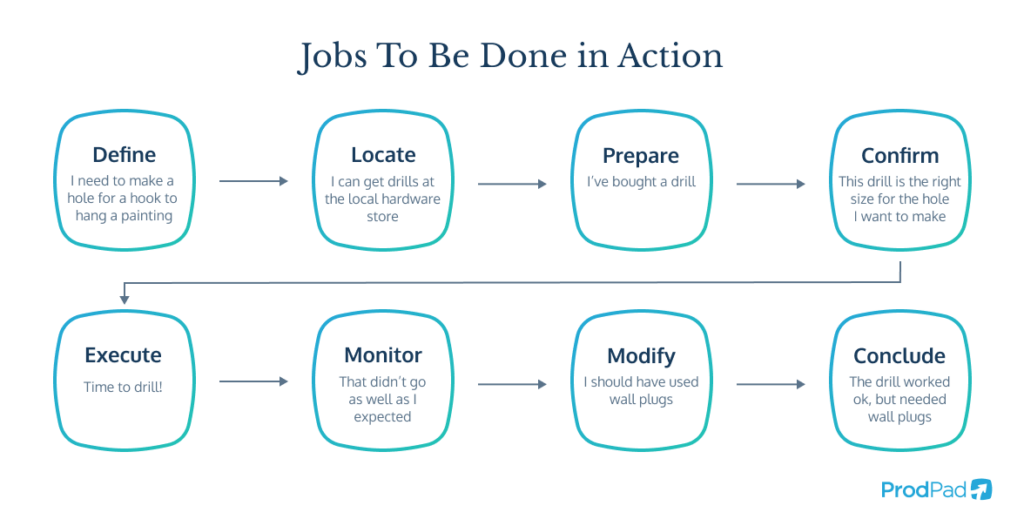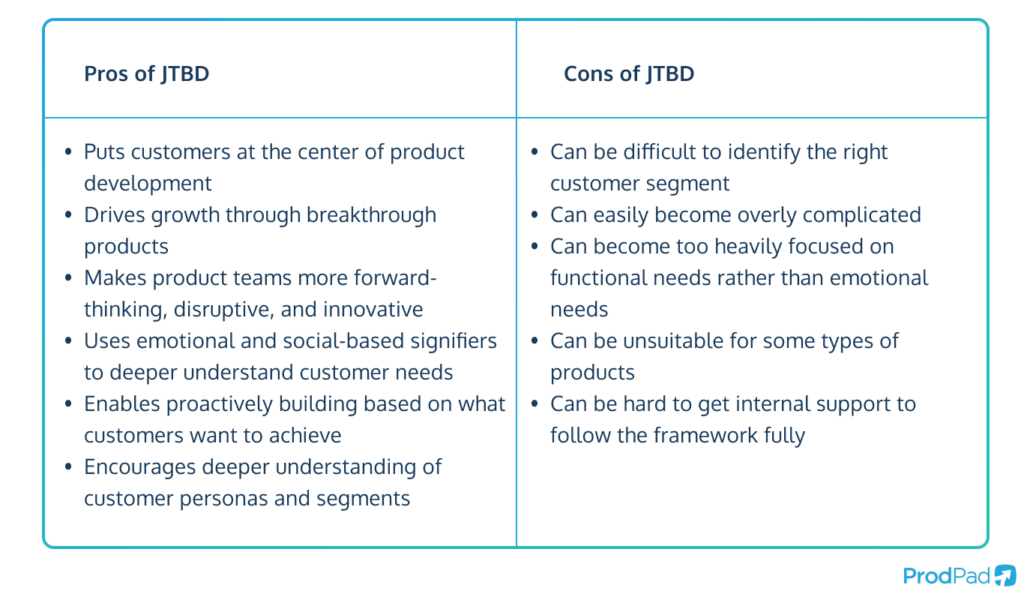Jobs-to-be-Done (JTBD)
What is the Jobs-to-be-Done framework?
The Jobs-to-be-Done prioritization framework (also called JTBD or Jobs Theory) is based on the idea that customers don’t purchase products or services based on their features or functions, but rather fulfill a specific job or task. It can be a powerful tool to help you develop a deep understanding of your customers and to drive innovation.
By understanding the customer’s job-to-be-done, you can create products and services that better meet their needs, ensuring that you are the one “hired” to do the job.

How does Jobs-to-be-Done work?
The JTBD framework consists of three main components:
- the job executor – the person who is trying to accomplish the job
- the job-to-be-done – the task or problem that the job executor is looking to solve
- the desired outcome – the result they’re trying to achieve
To use the old example, if someone buys a drill, it’s not because they want a drill but because they want a hole. The job executor here is the person buying the drill, the desired outcome is to have drilled a hole, and the job-to-be-done is making a hole.
If you create a drill that does the job better or more easily, and so more effectively satisfies the job-to-be-done, your drill will be the one “hired” to do the job again in the future.
JTBD is about putting the focus on your customer, their wants, needs, and emotions. You attempt to determine what is the over-arching need or desire that is driving them to use either your product or a competitor’s, and then you try to better serve that need or want.
It has the potential to jump-start innovation, as it forces you to anticipate customer needs rather than just reacting to them, as reflected by its original name, Outcome-Driven Innovation.
When using the JTBD framework, you will need to go beyond just understanding the functional aspects of the job-to-be-done. You will need to consider the emotional and social dimensions of the job, as these can often be the primary drivers of customer behavior.
By developing a deep understanding of the emotional dimension of your customers’ needs, you can create breakthrough products, as well as refine your customer experience into one that persuades your users that your product is the best solution to their problems.
What is the origin of the Jobs-to-be-Done Framework?
The Jobs-to-be-Done theory was first proposed by Harvard Business School professor Clayton Christensen and was further expanded and developed by Tony Ulwick, CEO of innovation consulting firm Strategyn. They have landed on different interpretations, though we are looking at Tony Ulwick’s “Jobs-as-Activities” approach rather than Clay Christensen’s “Jobs-as-Progress” theory.
Ulwick originally called his process Outcome-Driven Innovation, arguing that customers don’t buy products based on their features or benefits, but rather based on the job they need to accomplish. As Christensen put it, “Your customers are not buying your product, they are ‘hiring’ it to get a job done.”
Ulwick developed his version of the JTBD framework as a way to better understand these customer needs and motivations and has reportedly seen great success implementing it with his clients.

How does the Jobs-to-be-Done theory help in product management?
At its core, the theory asserts that instead of focusing on features or benefits, product managers need to understand the specific needs and motivations of their customers. This approach shifts the focus from product features to the real-world problems that your customers face, resulting in products that are more empathetic and effective.
By understanding the job-to-be-done and the desired outcome, companies can create products and services that better meet their customer’s needs. This can lead to improved customer satisfaction and potentially to you winning a bigger market share.
Designing products with Jobs-to-be-Done in mind requires a deep understanding of the customer and their experiences. This means looking beyond just functional aspects and understanding the emotional and social dimensions of the job that the customer is trying to accomplish.
Jobs theory also has implications for your product roadmap and strategy. Traditionally, you might base your roadmap on existing market trends or customer feedback. But with the JTBD approach, you can proactively anticipate and design your roadmap around the jobs customers might try to do in the future. This allows will encourage your product teams to be more forward-thinking, disruptive, and innovative.
One of the key benefits of applying the Jobs-to-be-Done theory to product management is the ability to identify under-served customer segments. By understanding the jobs that are currently poorly served by the existing offering, companies can tailor their product or service to meet those unmet needs.
Our incredibly useful eBook, The Product Manager’s Guide to Prioritization Frameworks, suggests the following simple method for implementing JTBD:
1. Identify the jobs: Start by identifying the most important jobs that your customers are trying to get done when they use your product. You could check your assumptions here through customer research, such as interviews, surveys, or online reviews.
2. Rank the jobs: Once you have identified the jobs, rank them based on their importance to your customers. You can use metrics such as the frequency of the job or the customer’s willingness to pay to get the job done.
3. Evaluate existing solutions: Evaluate the existing solutions that customers are using to get the job done. This can help you identify any gaps or opportunities for improvement.
4. Prioritize product features: Based on the most important jobs and the gaps in existing solutions, prioritize the product features that will help your customers get the job done better or more efficiently.
5. Get those top priorities on your product roadmap!

What are the benefits and drawbacks of JTBD?
JTBD can be a useful tool that could help you to create products that meet your users’ needs better than ever before. With JTBD, businesses can focus on the real-world problems their customers face and design products that are more empathetic and effective.
However, it’s essential to recognize both the benefits and drawbacks of using JTBD to guide product development. That way you can make an informed decision about whether to implement JTBD and how to use it to maximize its benefits.
Benefits of JTBD
Jobs-to-be-Done can help you in the following ways:
- It puts the customer at the center of product development, ensuring that their needs and desired outcomes are met, resulting in higher levels of customer satisfaction.
- It helps companies identify underserved customer segments and can tailor their product or service to meet unmet needs, creating a competitive advantage and even driving growth through breakthrough products.
- It encourages product teams to be more forward-thinking, disruptive, and innovative, leading to the creation of new markets and the growth of existing ones.
- It helps companies to better understand the emotional and social dimensions of the job their customers want to accomplish, leading to products that better meet their needs and generate higher levels of satisfaction.
- It enables a proactive approach to product development, concentrating on what the customer wants to achieve, rather than the current product, resulting in better predictability to innovation and a higher chance of success.
- It assists in developing a deeper understanding of your customer personas and segments. This understanding can guide your product roadmap and innovation efforts, potentially leading to a higher success rate for new product or feature launches.
Drawbacks of JTBD
Some of the challenges of implementing JTBD include:
- It can be difficult to identify the right customer segment and to fully understand their needs and desires. This requires a significant and potentially unfeasible investment of time and resources
- It can quickly become complicated and nuanced, especially if there are multiple jobs that customers are trying to accomplish. This can lead to confusion and disagreements among product teams, slowing down the development process.
- It might cause you to focus too much on the functional aspects of the job, without fully considering the emotional and social dimensions. This can lead to products that technically meet your customer’s needs, but fail to fully satisfy them.
- It may not always be applicable in certain industries or for certain types of products, such as those that are purely recreational or luxury items. In these cases, customers may be less concerned with specific jobs they need to accomplish and more focused on the overall experience or pleasure of the product.
- It may face resistance from within a company when suggesting fully adopting this approach and making the necessary changes to align with the JTBD framework.
The JTBD framework is a valuable tool if you’re looking to create breakthrough products and features that will actually satisfy your customers, and differentiate yourself from your competitors.
Emphasizing the customer’s job-to-be-done can help you to create products and services that are more effective, forward-thinking, emotional, empathetic, and ultimately successful.